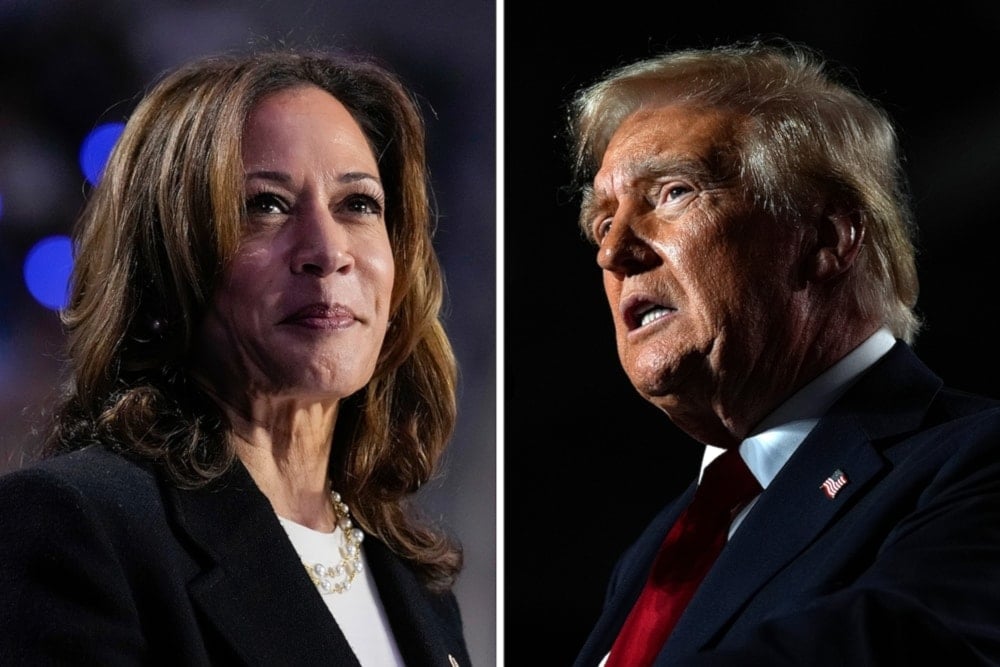Voting in turmoil: Americans brace for polls amid unrest fears
The race for the White House is entering its final phase, and early voting turnout has begun.
-

This combination of photos shows Democratic presidential nominee Vice President Kamala Harris, left, speaking during a rally in Charlotte, NC, Sept. 12, 2024, and Republican presidential nominee former President Donald Trump, right, speaking during a rally in Warren, Mich., November 1, 2024 (AP)
Election Day has arrived in the United States, with tens of millions of voters preparing to head to the polls on Tuesday for one of the closest and most significant contests in modern US history.
Democrat Kamala Harris and Republican Donald Trump appear to be locked in a razor-thin race, with national opinion polls showing little change in recent weeks.
The situation is similar in seven critical swing states—Michigan, Wisconsin, Pennsylvania, Arizona, Nevada, Georgia, and North Carolina. Recent polling has failed to reveal a clear pattern or advantage for either candidate in these electoral battlegrounds, although most experts agree that the winner of Pennsylvania is likely to gain a significant edge.
“If we win Pennsylvania, we win the whole ball of wax,” Trump, 78, declared at a rally in Reading during a frantic final day of campaigning in the state. Later, in Pittsburgh, he framed the election as a choice between “a golden age of America” if he returned to the White House or “four more years of misery, failure, and disaster” under Harris, as he articulated it.
Harris, 60, spent all of Monday in Pennsylvania, wrapping up her campaign in Philadelphia alongside singer Lady Gaga and TV personality Oprah Winfrey, who warned about the threat Trump poses to democracy. “We don’t get to sit this one out,” Winfrey stated. “If we don’t show up tomorrow, it is entirely possible that we will not have the opportunity to ever cast a ballot again.”
Swing states hold the key to election victory in electoral college showdown
The swing states will ultimately decide the election, as the US political system determines outcomes not by the national popular vote but through an electoral college that allocates electors based roughly on each state's population size. A candidate needs 270 electoral votes to win, and battleground states are those where polls suggest outcomes could go either way.
More than 78 million early ballots have been cast, but the final results may not be known quickly. With such tight polling, full results from crucial swing states are unlikely to be available on Tuesday night and may not even come in on Wednesday, leaving the US and the world anxiously awaiting the identity of the next president.
A turning point for America
The election marks the conclusion of an extraordinary and, in many respects, unprecedented campaign that has significantly polarized American society and heightened anxiety among many citizens, with warnings of potential civil unrest, particularly if Harris wins and Trump contests the results.
Throughout her campaign, Harris has consistently highlighted the autocratic threat posed by Trump. In her final major event, she held a rally attended by 75,000 supporters at the Ellipse in Washington, the same location where Trump encouraged his followers to storm the Capitol on January 6, 2021.
“On day one, if elected, Donald Trump would walk into that office with an enemies list. When elected, I will walk in with a to-do list full of priorities on what I will get done for the American people,” Harris told the crowd.
Her campaign has aimed to signify a turning point away from the Trump era and the dangers of his potential return to the White House. She has recognized that labeling Trump a fascist accurately reflects his political beliefs and the goals of his movement, while also asserting that she embodies a choice that will address the needs of all facets of America’s deeply divided political landscape.
Trump's grievance-fueled campaign sparks fears of violence and division
Trump, on the other hand, has conducted a campaign driven by a profound sense of grievance, stemming from his personal legal challenges and the perception among many of his supporters that America is suffering under Democratic rule.
This feeling of victimhood has been amplified by falsehoods and conspiracy theories that portray Biden and Harris as extreme leftists responsible for destroying the American economy through high inflation and a fixation on identity politics.
Additionally, Trump has made immigration and border security central to his campaign, depicting America as overrun with crime attributed to illegal immigration, often resorting to outright racism and fearmongering. He has described undocumented immigrants as “animals” with “bad genes” who are “poisoning the blood of our country.”
The stark divisions between the two campaigns and the rhetoric used by candidates—particularly Trump and his allies—have raised significant concerns about potential violence or unrest on Election Day and during the vote-counting process. In the lead-up to the election, ballot drop boxes designated for early voting were vandalized in several states.
Trump himself has faced two assassination attempts during the campaign. At a rally in Pennsylvania, a bullet grazed his ear, and at a golf course in Florida, a gunman was poised to ambush him but was thwarted by a vigilant Secret Service agent before he could fire. Neither assailant appeared to have a coherent political motivation or clear alignment with either side.

 5 Min Read
5 Min Read








